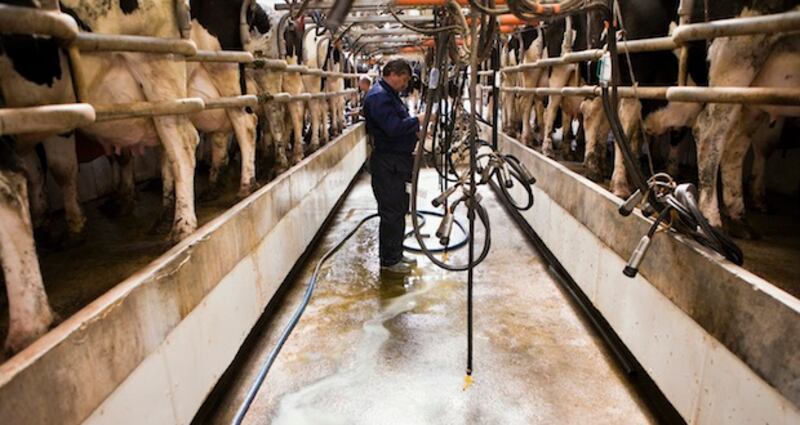Last month's announcement by Glanbia Food Ingredients of a €400 million investment in a plant in Belview on the Kilkenny/Waterford border, which will create over 1,600 jobs, proved a further boost to Ireland's buoyant food sector. There is now growing confidence that Ireland is well positioned to meet the ambitious targets set out in the Government's Food Harvest 2020 strategy, launched in 2010.
Among the targets in the strategy are increasing the value of primary output in the agriculture, fisheries and forestry sector by €1.5 billion a year, a 33 per cent increase on previous levels; increasing the value added in the agri-food, fisheries and wood products sector by €3 billion and achieving exports of €12 billion. The strategy is industry-led and puts an emphasis on a consumer-focused process to developing the industry around a sustainable, added value approach.
The explosion in world population, expected to hit eight billion by 2025, and the rapid rise in prosperity in China, amongst other markets, is a key component in the backdrop. Ireland has an enormous opportunity to leverage its pedigree, especially as a quality, sustainable grass based food producer.

According to Kevin Hanrahan of Teagasc, one of the team that put together the report, the objectives are realistic as the strategy and targets came from the industry itself with inputs from every stage within the food chain. “It’s ambitious but realistic at the same time,” he points out. “It’s not just about achieving growth it’s about going about things in a smarter way and achieving sustainable advantages around the promotion of the Ireland brand.”
As the report notes, environmental sustainability not only underwrites long-term growth but is, in itself, a powerful marketing tool. A major opportunity exists for Ireland if it can find ways to differentiate itself and take the lead in a market increasingly demanding low carbon food products. The sustainable element of the strategy has been boosted recently by a Department of Agriculture initiative to ensure rigorous environmental auditing, Hanrahan observes.
In growth terms, the powerhouse of the industry at the moment is the dairy sector. The abolition of milk quotas in 2015 is seen as a huge opportunity and it is estimated that this alone could be worth €1.4 billion. “The challenge is to get the maximum return from that opportunity and there is no scope for complacency. Developments, such as Glanbia’s announcement and Kerry’s new food innovation facility that will create 1,000 jobs in Naas, point the way,” says Bord Bia’s Padraig Brennan, noting that the sector has moved a long way from its commodity base pre-2000.
Innovation and responding to changing consumer needs and tastes in areas such as convenience and nutrition are key parts of the strategy, he adds.
While most agri-business sectors are doing well currently, progress is not even across the sector. While the beef sector, for example, has enjoyed significant price increases over the last three or four years, increased input costs mean that many beef farmers are actually losing money. “There isn’t the same sense of enthusiasm or optimism as you have in the dairy sector,” says Hanrahan, adding that the sector has been characterised by massive consolidation in recent years.
One sector that is doing well currently is the seafood industry. According to Bord Iascaigh Mhara (BIM), the sector has the potential to achieve €1 billion in sales by 2020 creating 3,000 new jobs in the process. The Irish seafood sector is currently worth €822 million to the economy, employs approximately 11,000 people and is showing major growth on the export market with sales up 18 per cent on 2011 to €493 million in 2012.
While there is declining demand and prices in traditional markets such as the UK, Germany, and France due to the downturn, the rise of China represents a massive opportunity, according to BIM chief executive, Jason Whooley, who says that a growing middle class there is driving increased seafood consumption. “Seafood consumption in China is expected to rise from 26 kilograms per capita per year today to 36 kilograms in 2020. Just a one per cent share of that market would be greater than 500,000 tons a year,” he notes.
Fish consumption is growing globally and it is expected to result in demand for an additional 42 million tonnes of seafood globally by 2030, he points out. While restrictive fish quotas have had a depressing effect on the Irish seafood industry for many decades, Whooley says that there is a lot of cause for optimism.
Another bright development for the food sector has been the emergence of a significant artisan food sector, in response to consumer demands for locally produced, hand-crafted food products. This has brought a new stream of entrepreneurs into the sector with many rapidly developing from micro entities into small and medium-sized food companies. Developing the scale of these firms could also play a very significant part in meeting the objectives of the Food Harvest 2020 strategy.









